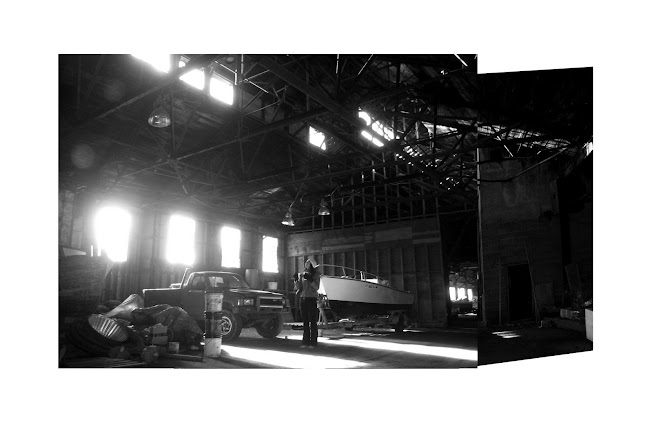thesis core_
PATTERN as it provides image to activity & image to form
pattern image/activity = inhabitation, program, experiential
pattern image/form = built culture, present choices of site
tested pattern [ideal]: "social production" [vs previous "fordist production model]
tested pattern [real]: existing collins axe factory campus [vs spatial/formal requirements of new facility]
architectural proposal: develop a seam that binds ideal patterns and real patterns
PATTERN DIAGRAM - EXPLORING THE IN-BETWEEN OF BINARY RELATIONS
or "exploring the seam of binary relations"
finding tertiary/ambiguous conditions in binary relations through layered & three-dimensional graphic analysis --> but what is the value of between binaries? predicated by the impossibility of living binaries (in conjunction with a western philosophical tendency to categorize them) (see Heidegger), binary conditions may represent "ideals", as in non-realities, while the real is a struggle within the dichotomy... an architectural intervention (an instrument for living) will be forced to mediate between ideal (in this case, social production model of renewable energy) and real (gravity & horizon, site parameters, program requirements, material properties, etc)
*see SEAMS exploration at the end of this document
IDEAL
program framework:
POOLS [info, hardware, feedback, assessment] + [recycle function + tangents of baths, brewery]
microcosm to thesis process of investigating pattern through play (emergent rules; discovery by hypothesis without "a priori" goal)
pools are embodiments of new energy flows [see: energy flows, water flows, activity flows]
map new flows - PROGRAMMATIC SEAMS... or seam among many edges/ends/lines?
POOL MODELS - place "on site" before further translation (digitally build the study models; scale and fit on site... what of the site/program taxonomy of conditions/needs?)
REAL
SITE DOCUMENTATION - MAJOR OMISSION
this site is used because it has stuff on it; what role does "stuff" have?
how is "stuff" an element of the new pattern? (see: old/new site activity pattern, but does not account for existing structures, artifacts, elements, material culture)
does "stuff" have a prevailing pattern of its own (see: repetition not essential, but rather structural precepts, i.e. rules for action)
relationship between existing building, proposed architecture, "kept" architecture
re: digital model - ghosty/milky mass/frames of existing structures that are inhabited, repurposed (same axe twiced)
charge: engage extant stuff
note- "extant" = protruding, visible, present
challenge of documentation; suggestions-
catalog "stuff" on site. current: "material traces", "buildings growth", "campus growth", "earth patterns"
re: "earth patterns" - see section studies describing embedded actions (example, carve, scrape, fill, retain, build)
SEAM
HOW DOES THE ARCHITECTURE GROW/FLOW?
consideration of time: through phasing?
WHAT IS THE FINAL IMAGERY OF THIS PROJECT?
animations? maps? pattern diagrams? section dwgs + models?
DESIGN DEVELOPMENT - SEAMS
seams = an in-between state of patterns, resolving patterns, bonding patterns;
[note: process has been caught as an "in-between" or "seam" of drawing & building (both the existing and proposed)
the example of flat-patterning in fashion provides a tangible example through which to explore this idea. while the role of the seam is to bind patterns, the seam itself can impact the discrete pattern itself. that is, the nature of the edge relationships (abutting, overlapping, face-to-face, etc) can cause new structural conditions within a pattern. a seam condition influences the choice of fabric (from straight and rigid to loose and flexible) or beget pattern edits (insertion of darts, hems, gathering, etc).
the design development of this thesis will focus on a selection of site "seams" by which to engage the existing and proposed patterns of site (material culture), activity, and form
so...
focus on the site conditions -
1 data collection of material site elements
2 model existing granite building [what of the metal sheds?... begin research via Assessment document]
3 study section drawings for latent "operations"; study for historical operations (overlay historical sections)
FEDERICA GOFFI - time material
from ACSA NEWS
Sustenance in Architecture: Making as
Re-making
Sheryl Boyle, Carleton U.
Federica Goffi, Carleton U.
In the contemporary western world there is a
disjunction between ‘architecture’ and ‘conservation’.
By redefining the meaning of sustainability
as being derived from sustenance, we
can reconsider our approach to this disjunction.
The continuty of ideas embodied in exisitng
building stock provides nourishment for architecture.
Rather than setting a dialectic oposition
of ‘new’ and ‘old’, architecture should be
read as a palimpsest. This session aims to provoke
speakers to reflect on the ‘sustenance’ of
sustainability as a way of breaking the barrier
between new and old, arguing that all past is
present and that all making is a remaking.
university of maryland school of architecture master of architecture program

No comments:
Post a Comment